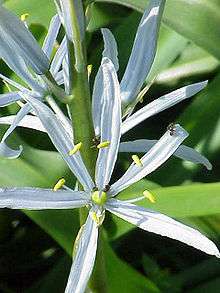Camassia cusickii
| Cusick's camas | |
|---|---|
 | |
| C. cusickii | |
| Scientific classification | |
| Kingdom: | Plantae |
| Clade: | Angiosperms |
| Clade: | Monocots |
| Order: | Asparagales |
| Family: | Asparagaceae |
| Subfamily: | Agavoideae |
| Genus: | Camassia |
| Species: | C. cusickii |
| Binomial name | |
| Camassia cusickii S.Watson | |
Camassia cusickii, common name Cussick's camas, is a species of plant in the Asparagaceae family (subfamily Agavoideae). It is native to parts of North America. It has linear leaves with parallel venation and flowers in parts of three. The flowers are usually ice blue or baby blue in color, although they can be various shades of blue, cream and white.
Distribution
Although scattered from coast to coast Camassia cusickii is more abundant in the northwestern states and is usually found in the Canadian Life Zone, and prefers damp meadows. Stations have been located in the Eagle Creek Mountains, Powder River Mountains and Blue Mountains of northeastern Oregon. Cusick’s camas self-seed and germinate easily, as long as they find rich, moist and well-drained soil.[1]
Habitat and ecology
A native to North America, the Camassia cusickii tolerates damp meadows at subalpine and alpine elevations (4,000–6,000 feet (1,200–1,800 m)) and tolerates pond edges, rich soils and bloom well in either sun or shade.
Morphology

C. cusickii grows from a bulb and has long basal leaves with parallel venation. The flowers are in parts of threes and the petals, which are usually of a pale blue, are long and slim. The flowers appear as a raceme on top of a long (up to 30 inches (760 mm)) stem. There can be 100 flowers in a raceme. The bulb formed by C. cusickii is believed to be the largest of this genus.
Food
It is believed that the Indians used this plant in their food preparations, although many find it to be inedible with a pungent and nauseous smell.
Culture
C. cusickii prefers fertile moist soil. The bulbs are usually planted 6 inches (150 mm) deep in late summer or early fall, but later planting can also be successful.
References
- ↑ Wiley, L. (1968). Rare Wild Flowers in North America. pp. 47–51.
External links
 Data related to Camassia cusickii at Wikispecies
Data related to Camassia cusickii at Wikispecies Media related to Camassia cusickii at Wikimedia Commons
Media related to Camassia cusickii at Wikimedia Commons- USDA Plants Profile for Camassia cusickii (Cusick's camas)